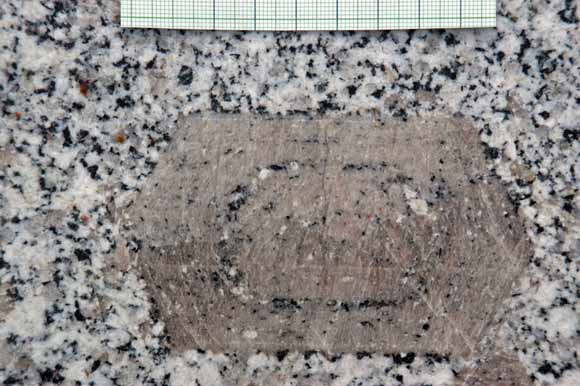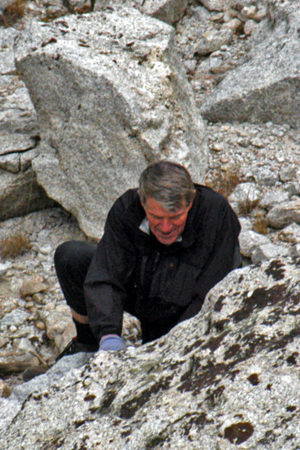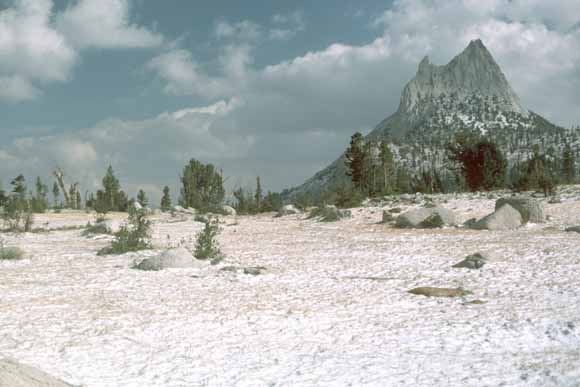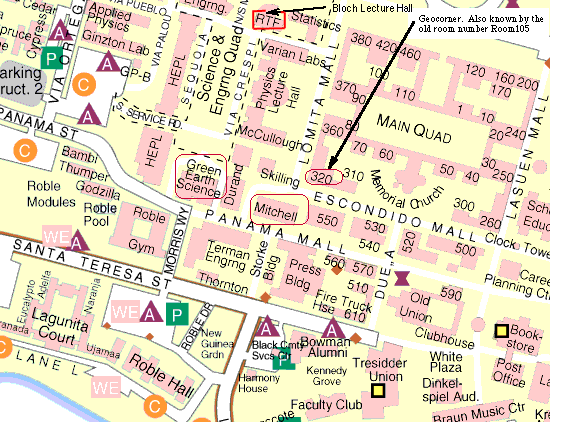
Location: Stanford University
see Map showing Mitchell and GeoCorner Room 320
This will be the 391st meeting since 1954
Officer nominees : Tom Moore, President; Keith Howard, Vice President; Mike Diggles, Secretary; John Spritzer, Treasurer; Elizabeth Miller, PGS Stanford University Coordinator; Bob Coleman, Field-Trip Czar

Four large granitic intrusions in the Sierra Nevada batholith that contain giant K-feldspar crystals span 300 km of the range crest. These 89–83 Ma plutons (and related porphyritic fine-grained masses) are the youngest in the range, and represent the culminating magmatic phase of the batholith.
The megacrysts in each of these igneous bodies attain 4–10 cm in length and all display oscillatory zoning. Each zone begins with a sharp increase followed by a gradual decrease in the concentration of BaO—commonly from 3 to 1 weight percent. Some of the more pronounced zones overlie resorption and channeling features on the underlying zone.
Trains of small mineral inclusions (plagioclase, biotite, hornblende, quartz, sphene, and accessory minerals) in the megacrysts are parallel to the BaO-delineated zones. These inclusions are elongate parallel to the zone boundaries and are sorted by size from zone to zone.
The growth temperature of sphene is estimated by use of a Zr-in-sphene geothermometer. The sphene grains included in K-feldspar megacrysts all yield igneous temperatures, mainly 735-760 °C, while lower temperatures are encountered in the groundmass sphene.
The oscillatory zoning of the megacrysts, their presence in quenched porphyry dikes, and the limited range and igneous values of growth temperatures, support the interpretation that the megacrysts formed as igneous sanidine phenocrysts, and that intrusion temperatures varied by only small amounts while the megacrysts grew.
Each Ba-enriched zone was apparently formed by a repeated surge of new, hot melt injected into the bottom of the magma chamber represented by the plutons. Each recharge of hot magma offset cooling, thereby maintaining the partially molten character of the chamber for a long time. Such recharging also induced convective currents that lofted settling megacrysts back up into the chamber for growth of one more zone. Such processes provided the necessary conditions for the origin of these extraordinarily large K-feldspar phenocrysts.

Jim Moore
He conducted geologic studies for several decades in the central Sierra Nevada, which led to the Stanford University Press book: “Exploring the Highest Sierra.” The book weaves together the history of exploration and mapping of the range with the development of pioneering geologic concepts. Another book recently published: “King of the 40th Parallel—Discovery in the American West” recounts the adventures of Clarence King who became the first director of the U.S. Geological Survey.
Jim also served as Scientist-in-Charge of the Hawaiian Volcano Observatory and investigated about 20 on-going volcanic eruptions world-wide. He has participated in about 25 oceanographic cruises and numerous dives in research submarines mostly to investigate volcanic rocks on the submerged flanks of young volcanoes.

Cathedral Peak; classic site for these types of granites
Reservations: The preferred way to make reservations is simply to email John Spritzer at jspritzer@usgs.gov by October 5, tell him you will attend, commit to pay, and bring your payment to the meeting. John always emails a confirmation; if you don’t get one, assume email crashed yet again and email him a second time. A check made to “PGS” is preferred, payable at the meeting.
If you want to pay in advance:
Stanford faculty and students: Please make dinner reservations by October 5. Contact Dr. Elizabeth Miller via her mailbox (and leave check), Geological and Environmental Sciences Office, Geocorner - Bldg. 320 (Rm. 205). Make checks out to “PGS.”
All others, including faculty and students from other Bay Area universities and colleges and USGS: Please make dinner reservations by October 5. Contact John Spritzer, at U.S. Geological Survey, 345 Middlefield Road, MS-973 _Menlo Park, CA 94025, Tel.: (650) 329-4933. Send check made out to “PGS” to John.
Dinner is $30.00. Includes wine (5:30 to 6:15 PM.) and dinner (6:15-7:30 PM.).
For students from all universities and colleges, the dinner, including the social 3/4-hour, is $5.00 and is partially subsidized thanks to the School of Earth Sciences, Stanford University (Note, no-show reservations owe the full price).
Doris, whose wonderful crew prepares our meals, asked that we let you know that people who are late RSVP’ing and people who show up without a reservation will be welcome but that they will be eating on paper plates with plastic utensils (food supply permitting).
Dues for Academic Year 2007-2008 ($10.00) should be sent to John Spritzer, U.S. Geological Survey, 345 Middlefield Road, MS-973 _Menlo Park, CA 94025. John’s phone: (650) 329-4933.
Officer nominees: Tom Moore, President; Keith Howard, Vice President; Mike Diggles, Secretary; John Spritzer, Treasurer; Elizabeth Miller, PGS Stanford University Coordinator; Bob Coleman, Field-Trip Czar

Date created: October 1, 2007
Last modified: October 1, 2007
Created by: Mike Diggles, Webmaster-Secretary, PGS.